
The Northern Australia - Eastern Indonesia- PNG Super Gas Province:
The Northern Australia - Eastern Indonesia- PNG Super Gas Province: Why So Much Gas and So Little Oil?* Peter M. Barber¹ and Jim Winterhalder² Search and Discovery Article #10475 (2013)** Posted January 29, 2013 *Adapted from oral presentation at AAPG International Conference and Exhibition, Singapore, 16-19 September, 2012 **AAPG©2012 Serial rights given by author. For all other rights contact author directly. ¹Basin Studies, ISIS Petroleum Consultants, Perth, WA, Australia (pbarber@isispetroleum.com.au) ²Burial Modelling, ISIS Petroleum Consultants Pty Ltd, Perth, WA, Australia Abstract The Northern Australia-East Indonesia Super Gas Province of Late Palaeozoic-Mesozoic age, extends from the Northern Carnarvon Basin through the Browse Basin into the Timor Sea (collectively known as the North West Shelf), along the southern edge of the Papua-PNG obduction zone into the Coral Sea. Numerous LNG projects along the North West Shelf (North Rankin, Wheatstone, Gorgon, Ichthys, Bayu-Undan) or in West Papua (Wiriager), and PNG, indicate the overwhelming gas-prone nature of Late Palaeozoic-Mesozoic petroleum systems along the former Northern Australian continental margin. Some 80% of all hydrocarbons discovered to date in this region comprise gas. This presentation explores the reasons why this should be the case and identifies where sweet spots exist for finding oil as well as gas. The distribution of oil- vs. gas-prone source rocks is controlled by successive Late Palaeozoic-Mesozoic passive margin extension, listric ramp-flat detachments, rifting and breakup, overprinted by 2nd and 3rd order global eustatic cycles of the northern Australian margin and its tectonic interaction and obduction during the Cenozoic with the West Papua-PNG foldbelt. Inherent within these tectono-eustatic cycles occur two major source rock types: Organofacies B (algal marine) and D/E (mixed terrestrial/algal) Oil-prone Organofacies B with original TOC's and HI's of over 6% and 600 HI, respectively, only occur in localised OxfordianKimmeridgian rhomboid syn-rifts, separated by incipient fracture zone, such as the Dampier, Vulcan and PNG foreland basins. Conversely, Organofacies D/E exhibit TOC and HI ranges of 2% and 300, respectively, and are much more widespread. These occur in lower delta-plain coals throughout the pre-, syn- and post-rift, accommodated by pronounced extension during the Late Permian-Triassic along basal detachments, depositing thick Upper Permo-Triassic to Jurassic fluvio-deltaic sediments with stacked coaly facies. Two hundred TCF of in-place gas has been found along the entire Northern Australian margin from the Northern Carnarvon Basin through West Papua to PNG. Yet-to-find fractal analysis suggests that substantial gas resources remain to be discovered, some of which will be reservoired in multi-TCF accumulations, offering considerable exploration incentives. Future oil discoveries will tend to be modest, being limited to existing rhomboid syn-rift basins, such as the Dampier and Vulcan sub-basins, or the obducted basins of the West Papua-PNG fold belt. Selected References Barber, S.A., 1994, Sequence Stratigraphy and Petroleum Potential of Upper Jurassic - Lower Cretaceous Depositional systems in the Dampier Sub-Basins NW Shelf Australia; in Proceedings of the Sedimentary Basins of Western Australia Conference Perth p.525-524. Bradshaw, J., Edwards, D., Bradshaw, M., Foster, C.C., Loutit, T., McConachie, B.A., Moore, A., & Summons, R., 1997, Australian and Eastern Indonesian Petroleum Systems, Proceedings of IPA Petroleum Systems Conference, Jakarta May 1997 p.141-153. Hall, R., M.A. Cottam, and M.E.J. Wilson, 2011, The SE Asian gateway: history and tectonics of the Australia-Asia Collision: London Geological Society, 381 p. Hill, K.C., Bradey K., Iwanec J., Wilson N., & Lucas K., 2008. Structural exploration in the Papua New Guinea Fold Belt. In; Blevin, J.E., Bradshaw, B.E. and Uruski, C. (eds), Eastern Australasian Basins Symposium III, Petroleum Exploration Society of Australia, Special Publication, 225-238. Longley, I.M., C. Buessenschuett, L. Clydsdale, C.J. Cubitt, R.C. Davis, M.K. Johnson, N.M. Marshall, A.P. Murray, R. Somerville, T.B. Spry, and N.B. Thompson, 2002, The North West Shelf of Australia – a Woodside perspective, in M. Keep and S.J. Moss, (eds.), The Sedimentary basins of Western Australia: Proceedings of the Petroleum Exploration Society of Australia Symposium, Perth, WA, v. 3, p. 27-88. Pepper, A.S., and P.J. Corvi, 1995, Simple kinetic models of petroleum formation, Part III: Modelling an open system: Marine and Petroleum Geology, v. 12/4, p. 417-452. Satyana, A.H, 2009, Emergence of new petroleum system in the mature Salawati Basin: keys from geochemical biomarkers, Proceedings of Indonesian Petroleum Association, 33rd Annual Convention, Jakarta, 5-7 May 2009. Teas, P.,2005: Structural and Tectonic Setting of the Off-shore Kutai Basin, Indonesia. 2005 SEAPEX Exploration Conference, Singapore. The Northern Australia – Eastern Indonesia – PNG Super Gas Province Why So Much Gas and So Little Oil? Peter Barber & Jim Winterhalder Isis Petroleum Consultants Pty Ltd Perth, Western Australia 18th September 2012 Acknowledgements This presentation is a working summary of the petroleum potential of the N. Australian margin including New Guinea It is dynamic snapshot in time We have drawn on following key published work: • NW Shelf Australia Petroleum Systems: Longley et al. (Woodside 2002) • N Australia Oil Families: Bradshaw, Summons, Edwards & Kennard (GA 1997) • West Papua Petroleum Systems: Satyana et al. (BPMigas 2003, 2009) • PNG Tectonics & Petroleum Systems: Hill et al.(Oil Search 2004-2011) • Australia v SE Plate Tectonics Hall et al. (RHUL 2000-2012) • Timor Sea, Browse & N Carnarvon Basins: ISIS non-exclusive reports Northern Australia Margin Current and Future Gas Project Areas Tangguh (LNG) Papuan Basin (LNG) Bonaparte Basin (LNG) Browse Basin (LNG) Ichthys, Prelude NW Shelf (LNG) Gorgon, Wheatstone, Pluto Gladstone (CSG) • 11 LNG Projects under construction or planned • US$220 billion investment • By 2020 Australia will be No 1 LNG producer worldwide • LNG exports to double to 360 MMTpa by 2035 Predominance of Gas Late Permian Gondwana & Mesozoic Westralian Super System (Geoscience Australia 1996) 20 Bln boe • 7 key basins (12 total) 15 Bln boe • At least 375 Oil & Gas Fields 10 Bln boe • >270 tcf gas • >8.2 billion bbl Oil & Cond Salawati Bintuni Papua Vulcan 5 Bln boe Browse Bonaparte N. Carnarvon • Total: >46 Billion boe 22 Giant Gas Fields (>3 TCF rec) 17 in Australia, 3 in West Papua, & 2 in PNG 1 Giant Oil Field (>500 Million Bbls rec) 1 in West Papua Relative mix is 80% gas vs 20% oil Notes: 1. Primary source Australian state DPE’s 2. Reserve estimates are recoverable 3. P50 values quoted What Are The Key Oil vs Gas Drivers? 1. Plate Tectonics: Crustal Architecture Foundation 2. Petroleum Systems: Organic Matter Type 3. Eustasy: 2nd Order Transgressive – Regressive Cycles 4. Trap Styles: Extensional vs Compressional History 1.1 Plate Tectonic Drivers: Gondwanaland vs SE Asia Gondwanaland breakup interaction with SE Asia island arc systems Interplay of 3 Main Vectors: •Northward subducting Indo-Australian plate. •Westward subducting Pacific/Philippines plate. •Southeasterly extruding Sunda plate From Teas (2005) 1.2 Plate Tectonic Drivers: Present Day Plate Tectonic Terrains Gondwanaland NW Australian Shelf is one of the largest worldwide Resultant plate tectonic controls on petroleum provinces: •Extensional terrains: Syn-rift rhomboids/post-rift sag, i.e., NW Shelf: Exmouth-Timor Sea •Compressional terrains: Post-rift inversion: Papua Mobile Belt 7 •Wrench terrains: Syn-orogenic collapse: Salawati Basin 1.3 Plate Tectonics Setting: Indicative Current Reserves Basin Basin Setting Reserves (Bln boe) Rec) North Carnarvon Browse Vulcan Bonaparte Passive margin extension: syn-rift 22.2 7.5 0.7 6.7 Papua Bintuni Post-rift orogenic belt: syn-rift inversion 4.8 3.7 Salawati Synorogenic collapse basin 0.8 Australian Passive Margin Extension •Long-lived Permian – Mesozoic subsidence history •Relatively stable, large extensive shelf •Tertiary sediment offlap loading Australian – New Guinea •Initial long-lived stable pre-Tertiary history •Unstable, massive shortening in Tertiary •Fold belt loading Late Tertiary loading in both areas: increased maturity – gas window. 2.1 Petroleum Systems Drivers: Organic Matter Type 3 main types of organofacies (Pepper & Corvi 1995) indicated within the Northern Australian Late Gondwana & Westralian systems Organofacies D/E Lower delta coals Higher plants 70% gas 30% oil Organofacies B Restricted Marine Marine algae 80% oil 20% gas Organofacies A Bathyal carbonates Marine algae >80% oil Gas Prone (with minor oil) Oil Prone Limited abundance of oil-prone macerals along N Australian Margin is key factor relating to predominance of gas 2.2 Petroleum Systems Drivers Source Rock Packaging Post-Rift 2 50 Key source rock qualities: Tertiary 25 Bintuni Salawati A Pliocene Palaeocene Campanian 125 150 B Kimmeridgian B Oxfordia n Jurassic 175 Valanginian Regional Callovian 00 B Exmouth PNG TOC: 29 Barrow, Dampier, Vulcan HI: 458 PNG? D/E Toarcian Triassic D/E A Dampier TOC: 81 HI: 530 Rankin TOC: 21 Dampier HI: 500 Misool TOC: 15 Timor HI: 564 Bintuni TOC: 80 Petrel, N Carnarvon HI: 400 D/E Late Permian 250 D/E Post –rift 1 Lopinginian 275 Petrel TOC: 88 Perth, West Papua HI: 280 LEGEND Regional Seal D/E A B Local Seal TOC/HI Maximum Values Lower Delta Plain Coals A: TOC: 15 HI: 554 B: TOC: 21-88 HI:280-530 D/E: TOC: 2-29 HI:336-458 Bintuni TOC: 44 Bonaparte HI: 200 D/E 200 225 Browse TOC: 2 Flamingo HI: 336 Pre-Rift 2 100 Cretaceous 75 Syn 2 0 Restricted Marine Shale Bathyal Carbonates Main influence on source pods / types is tectonic controls on EOD Key source rock sequences occur in pre- and syn-rift 2 3. Eustasy Drivers Chronostratigraphy 205 Impact of 2nd order cycles on source and reservoir distribution • Widespread Triassic to Mid-Jurassic deltas/paralics: • • • Source (D/E) coals and Reservoir Localised Late Jurassic syn-rift oil source pods 90-95% of accumulations beneath Valanginian regional seal • Challenge to find reserves up and down section Adapted from Longley (2002) Post –rift 1 Pre-Rift 2 Syn 2 Post-Rift 2 NWS 3.1 Petroleum Systems Drivers Gas Condensate Ratios & Phase Despite magnitude of gas presence, high GCR in places GCR Modifiers: •Facies distribution •Maturation, Phase, Rate of Burial & Expulsion Efficiency: • Rapid subsidence = early expulsion of gas & condensate in same phase •Levels of TOC: • Lean Organofacies “B” SR will not expel oil but remain in situ, cracking to gas •High levels of GOR improves economics • Fast track production at Bayu (CCR >100 bbls/MMcf) Gas Wettness Bayu-Undan Echuca Shoals-1 Sunrise-Troubadour Ichthys Complex Crux Swan-1 Calliance Bilyara/ Montara/ Tahbilk Cash/Maple Brecknock-1 Tern Abadi Argus Torosa Barossa Blacktip 1 Petrel Evans Shoal-1 Prometheus 0 20 40 60 80 CGR (Bbl/MMcf) 100 120 4.1 Extensional vs Compressional Regimes GCR Drivers Gas Trap Tertiary Progradational Loading • Passive Margin Block Faulting • Slow loading: late gas phase only SR Tertiary Fold Belt Loading Oil Trap SR • Inversion & compressional folds (thin & thick skinned): • Rapid loading: Liquids & gas expulsion same phase Fast Tertiary Burial = higher P/T increase & fracturing = same phase Gas Condensate 4. Trap Style Drivers: Emerging Plays Extensional & Compressional Regimes Papuan Basin Fold Belt From Hill et al. (2011)) PNG Fold Belt emerging plays: Basal inversion detachment footwall traps: Mid/Upper Jurassic sands Dampier Sub Basin From Barber (1998) Dampier Basin emerging plays • Base Oxf & Kimm LST BFF beneath local seal • M australis BTS within regional seal on peri-rift 14 Overall Syn-Rift Petroleum Systems Model Source rocks: 1. Lower Mid Jurassic coals (Type D/E) 2. Upper Jurassic syn-rift restricted marine (Type B) 3. Triassic pre-rift deep carbonate (Type A) Reservoirs: 1. Mid Jurassic paralics 2 Triassic paralics horst block 3. Up Jurassic axial turbidites, shelfal Cretaceous sands 4. Mid Jurassic carbonate buildups In PNG compressional regimes, listric faults are loci for inversions Where did the Source Pods Evolve? Late Permian (225-250 Ma) EOD & Petroleum Systems Tangguh Gas Source Replace with map Petrel Gas Source Major crustal extension during Permian: Sibumasu breakup: Extensive lower delta plain (“LDP”) coal source: Tangguh & Petrel Fields Mid Triassic (205-250Ma) EOD & Petroleum Systems Bula Carbonate oil source Timor Carbonate oil source seeps Replace with map Gorgon, N Rankin, etc. LDP Gas Source • Continuing post-Sibumasu breakup subsidence & crustal extension • Massive LDP coal source: Gorgon, Io Janz: N Carnarvon Gas Fields • Bathyal carbonate source: Bula Field: Seram/Misool & Timor seeps Early – Mid Jurassic (160-205Ma) EOD & Petroleum Systems Potential Bath-Call oil source? Tangguh mixed oil / gas source? Browse-Timor Sea gas/condensate source? Replace with map Exeter / Nebo mixed oil / gas source? NW margin: subsidence / accommodation: extensive LDP coals Cessation Tasman terrains - initial passive margin/syn-rift? in New Guinea Late Jurassic-Early Cretaceous (140-160 Ma) EOD & Petroleum Systems Vulcan & Flamingo Trough Vulcan Kimm source kitchens PNG Fold Belt Kimm source kitchen Replace with map Barrow Dampier Exmouth Sub-basins Kimm oil source NW margin: progressive Ju-Kl syn-rift & breakup: Local restricted marine rifts: oil-prone source pods (D swanese Kimmeridgian) Possible local Kl source: Bayu Gas Condensate Field Late Cretaceous (65 – 140 Ma) EOD & Petroleum Systems Major 2nd floodback (regional seal) with local 3rd order lowstand turbidites Post-rift passive margin cooling and major floodback towards craton (Late Cretaceous 2nd order regional seal: ~95% all accumulations) Late Cenozoic: Miocene (0-25.5 Ma) EOD & Petroleum Systems Salawati Basin syn-orogenic carbonate-rich source Progressive development of Papua Fold Belt Major subsidence and cooling with Tertiary offlaps (gas charge) NW Shelf: continued cooling / subsidence and Tertiary carbonate progrades New Guinea fold belt: 1. Early thick-skinned inversion & 2. Later thin-skinned compressional regimes: major trapping ; Salawati syn-orogenic basin Future Potential Composite Petroleum Systems Salawati Oil Province with Deep Gas West Papua Oil Province with Deep Gas Gondwanaland Bintuni Gas Province with shallow Oil NW Shelf Gas Province West Local Oil Pods Permian “A” Oil: Ceram & Salawati Late Jurassic: “B” mixed oil/gas: Barrow Dampier Exmouth Vulcan , New Guinea Triassic-Mid Jurassic “D/E” Gas & minor oil: NW Shelf What About the Yet To Find (“YTF”)? In nature, ranking and field size distribution follows a lognormal distribution Log-normal distribution is propagated from the largest field in the basin with apparent breaks in the existing distribution indicated by missing fields with ranked size While subjective (should be used in conjunction with other analyses such as historical creaming curves), it provides some indication of the YTF 2 case examples presented of log /parabolic function 1. Carnarvon Basin: Maturing E & P Province 2. Papua Basin: Immature exploration Carnarvon Basin Parabolic Reserves: Maturing E & P Province Blue area is YTF Papuan Basin Immature with Considerable Upside Elk Hides Blue area is YTF P'Nyang Barikewa Australian Northern Margin YTF Discovered vs YTF distributions for N. Australian Basins Bln boe rec North Carnarvon Browse Vulcan Bonaparte PNG Bintuni Salawati Total Discovered 22.2 7.5 0.7 6.7 4.8 3.7 0.8 46.4 Yet to Find 13.3 3.1 1.2 2.6 8.1 1.3 0.1 29.7 Estimated Total 35.5 10.6 1.9 9.3 12.9 5 0.9 76.1 • 46.4 Billion Bbls Total Discovered So Far in 7 key Basins • 29.7 Billion Bbls Oil Equivalent: YTF Future Potential YTF Possibilities 0.8 Bboe Salawati Oil Province with Deep Gas 1.3 Bboe Bintuni Gas Province with shallow Oil West Papua Oil Province with Deep Gas Gondwanaland 8.1 Bboe 1.2 Bboe 2.6 Bboe 3.1 Bboe 13.3 Bboe NW Shelf Gas Province West Local Oil Pods Permian “A” Oil: Ceram & Salawati Late Jurassic: “B” mixed oil/gas: Barrow Dampier Exmouth Vulcan , New Guinea Triassic-Mid Jurassic “D/E” Gas & minor oil: NW Shelf Conclusions Quo Vadis? Discovered YTF distributions for N. Australian Basins • 46.4 Billion boe Total Discovered So Far in 7 key Basins • 29.7 Billion boe YTF • If 80% 20% GOR ratio applied, YTF is mostly gas due to: • Gas-prone source and deep, slow burial along large, stable shelf • Exceptions apply: • Under-explored local oil-prone Kimmeridgian syn-rift basins such as the Papua Basin. • Carnarvon Basin: Largest overall rating, potential for large fields, most potential for modest size fields • Papuan Basin: YTF oil pools will be large, unless deep early inversion targets are late gas charged THANK YOU With special thanks to the ISIS Perth team in preparing this paper, notably the following: • Dr Enrique Carballido: Editorial • Mike Bubrzyski, Adrian Ellins & Simon Barber: CAD & IT
© Copyright 2025


















